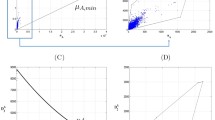Summary
Using as a primary standard a representative set of 208 proteins whose amino-acid-residue mole frequencies have been accurately established, a set of standard distributions of mole frequencies is defined for each amino acid, in terms of which percentile values for the observed mole frequencies of the amino-acid residues in any other protein can be determined. Data so transformed have a distribution much closer to Gaussian than untransformed values, and allow meaningful determinations of correlations between the amino-acid-residue compositions of two proteins as well as between pairs of amino-acid-residues within groups of proteins. Of the 153 possible pairs of amino acids (Asx and Glx are used) 39 are significantly correlated atp ≤ 0.01 and 22 atp ≤ 0.001. A percentile table is included for those wishing to use the method with programmable calculators.
The transformed data for amino-acid compositions have been used to perform principal components analyses on groups of proteins in order to determine if meaningful sub-groupings (observable clusters in scatter diagrams) were detectable. Such analyses are shown for the representative set of proteins and for a group of 184 globins. With regard to the globin chains, a correlation is observed for alpha chains in the first principal component projection (PCP), (accounting for 22% of the variance) with respect to the evolutionary time-scale while beta chains show such a correlation in the first and second PCPs (22% and 18% of the variance respectively). Thus, alpha and beta chains appear to diverge from a common progenitor, similar in position to globin chains from “primitive” forms. Furthermore, globins from “primitive” forms are nearer to one another than they are to globins from the vertebrates, a finding without a priori reason, suggesting perhaps that once a chain has reached a stable relationship with its environment, strong constraints are placed on the co-existing globin chains so that they maintain appropriate interaction with one another. In addition, positions of the epsilon, gamma and delta chains are in the order: epsilon (embryonal) more primitive than gamma (foetal) more primitive than delta equal to beta (adult).
Similar content being viewed by others
References
Black JA, Harkins RN (1977) J Theor Biol 66: 281
Clegg JB, Gagnon J (1981) Proc Natl Acad Sci USA 78:6076
Cornish-Bowden A (1977) J Theor Biol 65:735
Cornish-Bowden A (1979) J Theor Biol 76:369
Deman JR, Gracy RW, Harris BG (1974) Comp Biochem Physiol 46B:715
Doolittle RF (1979) The Proteins Vol 4, Neurath H, Hill RL (eds) Academic Press, New York p 1
Doolittle RF (1981) Science 214:149
Enslein K, Ralston A, Wilf HS (1977) Eds of statistical Methods for Digital Computers. John Wiley & Sons, New York
Harris CE, Kobes RD, Teller DC, Rutter WJ (1969) Biochemistry 8:2442
Harris CE, Teller DC (1973) J Theor Biol 38:347
Kirschenbaum DM (1971) Anal Biochem 44:159
Kirschenbaum DM (1972) Anal Biochem 49:248
Kirschenbaum DM (1973a) Anal Biochem 52:234
Kirschenbaum DM (1973b) Anal Biochem 53:223
Kirschenbaum DM (1973c) Anal Biochem 56:208
Kirschenbaum DM (1974) Anal Biochem 61:567
Kirschenbaum DM (1975a) Anal Biochem 66:123
Kirschenbaum DM (1975b) Anal Biochem 66:303
Kirschenbaum DM (1975c) Anal Biochem 65:466
Kirschenbaum DM (1975d) Anal Biochem 66:590
Kirschenbaum DM (1977a) Anal Biochem 83:484
Kirschenbaum DM (1977b) Anal Biochem 83:521
Marchalonis JJ, Weltman JK (1971) Comp Biochem Physiol 38B:609
Marriott FHC (1974) The Interpretation of Multiple Observations. Academic Press, London
Metzger H, Shapiro MB, Mosimann JE, Vinton JE (1968) Nature 219:1166
Ohnishi K (1978a) Evolution of Protein Molecules, Matsubara H, Yananaka T (eds) Japan Scientific Societies Press, Tokyo p 75
Ohnishi K (1978b) Proc of the 2nd Int Conf on the Origin of Life. Noda H (ed) p 471
Ohnishi K (1978c) Information System for Studies on Molucular Evolution: Report I. Noda H (ed) Japan Ministry of Education, Tokyo p 37 (in Japanese)
Reeck GR (1976) Handbook of Biochemistry and Molecular Biology: Proteins Vol 3 Third edn, Fasman GD (ed) p 504
Reeck GR, Fisher L (1973) Int J Pep Prot Res 5:109
Shapiro HM (1971) Biochem Biophys Acta 236:725
Smith MH (1966) J Theor Biol 13:261
Thompson EOP (1980) In: Evolution of Protein Structure and Function p 267
Williamson PG (1981a) Nature 293:437
Williamson PG (1981b) Nature 294:214
Author information
Authors and Affiliations
Rights and permissions
About this article
Cite this article
Reisner, A.H., Westwood, N.H. Assessment of similarities of pairs and groups of proteins using transformed amino-acid-residue data. J Mol Evol 18, 240–250 (1982). https://doi.org/10.1007/BF01734102
Received:
Revised:
Issue Date:
DOI: https://doi.org/10.1007/BF01734102




